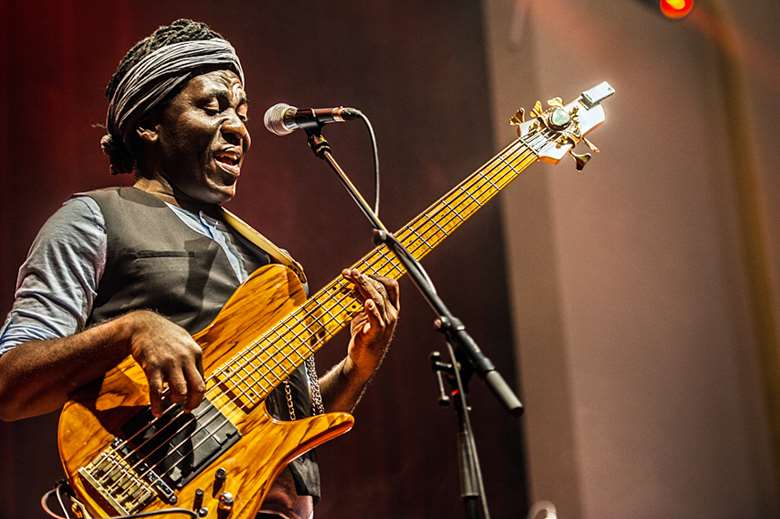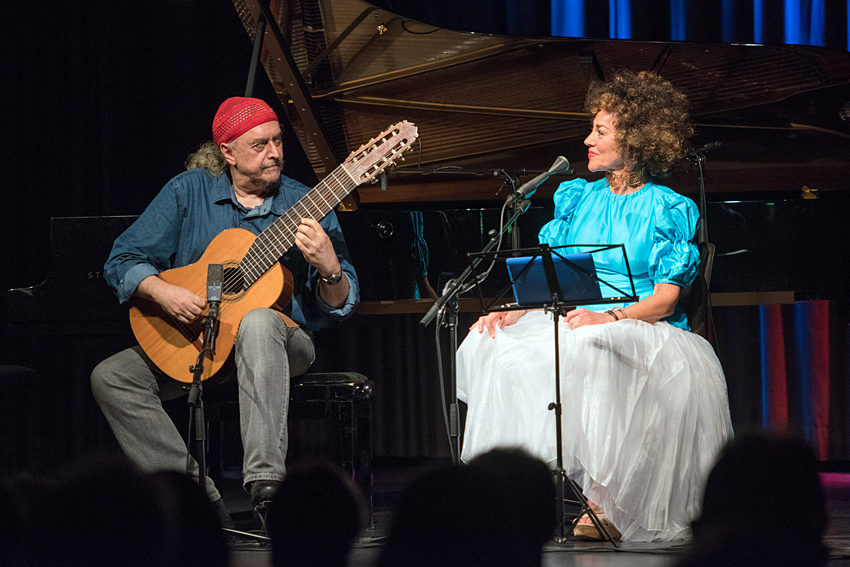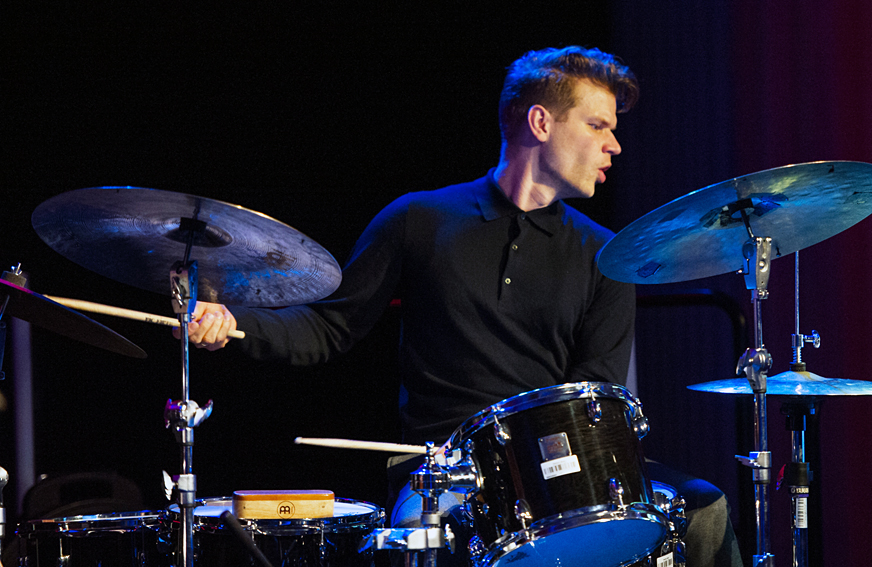Richard Bona brings the boogie and Amok Amor unleash improv anarchy at Enjoy Jazz
Friday, November 3, 2017
Some festivals cram everything into a single weekend, but Enjoy Jazz, in the south west of Germany, is an epic affair, beginning on 1 October, and still in progress now, until 11 November.

There are one or two concerts each evening, divided between three reasonably proximate cities: Mannheim, Ludwigshafen and Heidelberg. This is its 19th year, and though springing from a jazz source, Enjoy includes a well-chosen selection of satellite acts, including Oren Ambarchi, Gonjasufi, and Lapalux. Its jazz reach is also broad, embracing artists such as Archie Shepp, Vijay Iyer, BadBadNotGood and the Hot 8 Brass Band. Much of this good taste emanates directly from festival director Rainer Kern.
While your Jazzwise scribe was in town, most of the gigs happened in Ludwigshafen, a chemically-orientated city which is home to the BASF industrial colossus, one of Enjoy's principal supporters. We might primarily recall them as manufacturers of cassettes and reel-to-reel tape, but they also have other substances bubbling out of their cooling towers. Like Bournville, in Birmingham, this company has a spreading influence over its home city, but it's not chocolate aroma we're inhaling. Your scribe's room boasted one of the best full-wall hotel artworks ever experienced, a vast impressionist portrait of the BASF chemical works. Indeed, all three venues visited in Ludwigshafen are operated by this company, and they're all impressive, in their different fashions.

Egberto Gismonti (guitar/piano) and Maria João come together from Brazil and Portugal, appearing at Das Haus, to a capacity crowd. We don't get too many chances to catch Gismonti, so this was a valuable opportunity to witness these two, collaborating on their short European tour. The set opens with Gismonti playing solo on 12-string acoustic guitar, bending, plucking and twisting the notes within his serpentine phrases, but in a softly sensitive fashion. He's causing string-distress, but in an open-strumming, harp-like, or zithery way, naturally scintillating. Gismonti's fingers make a mobile spider-splay on the guitar neck, sliding gracefully up and down, in fixed position, gently pressing down on the tautness. Next, he moves to the piano, creating swells and ripples, dancing rivulets that are not particularly smooth, but often quite violent, as they make their scampering, headlong rush.
Gismonti is wearing a red tea cosy on his head, with an electric blue shirt, but he is perhaps upstaged by Maria João's blooming skirts, puffed sleeves, stack heels, big hair, and certainly by her possessed energy levels. Actually, perhaps 'upstaged' is not the word, but more 'distracted', as her ebullient personality, displayed in visual and aural modes, frequently forces the audience to focus on her, somewhat obscuring the actions of Gismonti, now back on guitar. He plays, she responds, mostly using a scat-cum-free improvisation vocabulary, and often directly mimicking or continuing his lines. They jape and frolic, as the seated João rides her imaginary steed, taking it down to a whisper, then rattling her skull-chompers like a marionette. João has a very expressive theatricality, usually having fun at the expense of herself, her straight man Gismonti, or the world in general. Her voice sometimes reveals a vibrato-ed operatic training, concealed in its depths, but she's also well into raunchy cabaret. As the set progresses, and João rarely ceases vocalising, it's necessary to avoid looking at her, homing in on Gismonti, which lends a peculiar change of emphasis in the musical perception. Back at the piano, with João now standing, the bastard mix of jazz, opera, fado and music hall continues, as she mocks the conventions of a formal speech-address, while Gismonti leaves the stage. As the set crept towards the 90-minute mark, there were inevitably some repeated moves, but this was a fine opportunity to make a rare sighting of Gismonti, even if he could have had a touch more time to himself.
In another BASF concert hall, Feierabendhaus, the South American vibration continued with Richard Bona's Mandekan Cubano, which combines the sound of Havana with traces of the bassman leader's Cameroonian roots. It's a story of the continuing feedback between latin and West African musics. Being a formal, and impressive, concert hall, perhaps this wasn't the best choice for a gig that was guaranteed to prompt dancing, but from an early stage, a certain proportion of the seated audience relocated to the raised sides of the hall. Each number revealed varying ratios between Africa and the Caribbean, with some of them being almost completely over one side of the Atlantic, or the other. One minute there's a ripping trumpet solo, riding high above the theme, the next, it's crisply muted and perfectly restrained. Strong solos also rotate between the trombone and piano, with room for sedate balladry too, as Bona himself solos with a flutey sound, imparted by his transformational effects pedals. Pianist Osmany Paredes penned 'Santa Clara', a dazzling acid salsa, bustling and lusty, featuring a 1970s-fuelled guitar solo. Bona has such magnetising powers that he can confidently wave goodbye to his band, at what could be almost set's end, slowing things down for a solo showcase of tall tales, bass-loop construction and songbird vocalising, keeping the audience gripped. He then engages in some of the most successful audience participation routines ever heard, actually conducting the crowd to constructive end, as he shapes hummed tones and male/female chorus divides, ending up building an elaborate 'proper' song experience.

The Enjoy Jazz festival has a fine approach towards contrasting styles, so the next evening, it's back to another BASF venue, the smaller, but still refined, Gesellschaftshaus, an unlikely home for an Amok Amor gig. Normally, we'd expect to catch this extreme-density math-jazz quartet in a DIY converted slaughterhouse, but here they are in a recital hall that probably mostly houses chamber classical ensembles. This is the last chance to catch them in their original form, as trumpeter Peter Evans is departing soon, and it's not clear whether the band will continue. The other players are Wanja Slavin (reeds), Petter Eldh (bass) and Christian Lillinger (drums). Evans rattles out a free military bugle scatter, a scramble of acupuncture notes, whilst Eldh's bass acts as a monomaniac fulcrum, insistently standing its ground. Riffs are on the run, constantly, slamming into new patterns with each resolution of loaded tension. Slavin plays an accelerated bebop alto solo, cloned into something way beyond, the lightning horns duelling frenetically. Evans envelops the microphone with his bell, plunging deep, with Slavin traipsing off on clarinet. Lillinger is in constant rummaging motion, flabbergasting in his continually inventive constructions. The entire set is compacted into not much more than 50 minutes, including the encore, but Amok Amor pile in so much ultra-detail that this was three hours of material, when judged by conventional combo notational rules. We'll sorely miss them if they cease!
– Martin Longley
– Photos by Christian Gaier